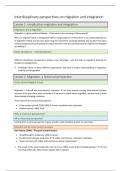Samenvatting
Samenvatting - Interdisciplinary Persp: Migration & Integration_uitgebreid
Deze volledige samenvatting omvat de powerpointslides die gebruikt werden tijdens de les en notities genomen tijdens de les en op basis van de opnames. De volledige inhoud van het vak interdisciplinary perspectives on migration and integration (IPMI) is verwerkt in deze samenvatting. This compr...
[Meer zien]



